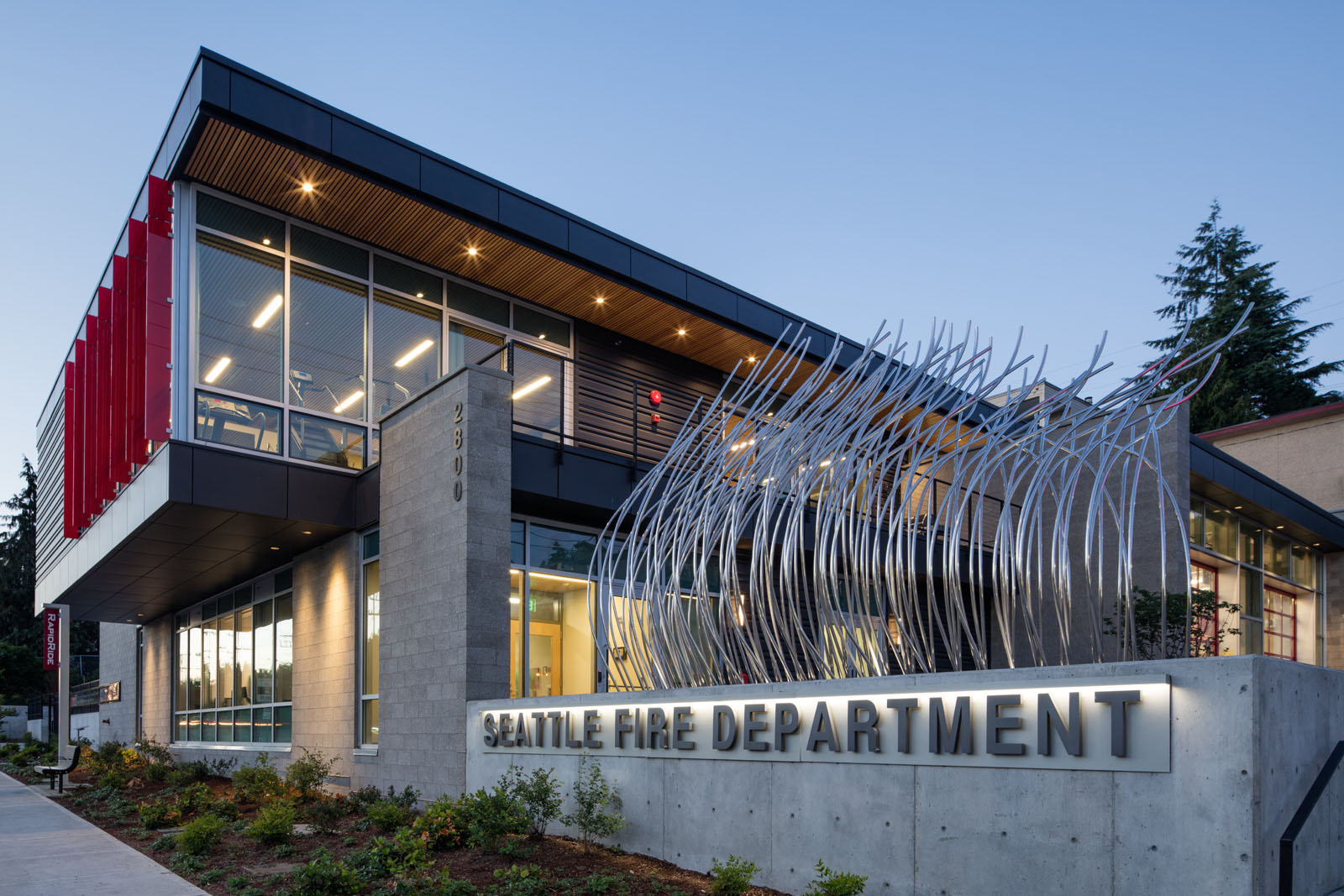“Seattle is known worldwide for its environmental leadership. City policy mandates LEED Gold for new construction, and we’ve gone well beyond that with this new fire station” – Mayor Edward Murray.
Durability, efficiency and functionality were core to the design of a new building for Fire Station 20. With modest, yet striking architecture, the building is unassumingly the most sustainable fire station in the United States. Located on a new site nestled into the steep slope of Queen Anne hill, the building has a strong civic presence, interspersed between predominantly industrial buildings on 15th Avenue W, making it an ideal location to showcase sustainable design.
Sustainable fire stations in Seattle
In 2003, citizens voted in support of the City of Seattle’s Fire Facilities and Emergency Response Levy to generate $167 million to upgrade, renovate or replace 32 neighborhood stations to seismic and modern firefighting standards. A key component of the City’s project was a commitment to achieving the U.S. Green Building Council’s Leadership in Energy and Environment Design (LEED) certification. LEED is an independent sustainable design rating system in which participating projects earn points for green features, meeting one of four certification levels (ranging from certified, silver, gold, with platinum as the highest level). The City’s station improvement initiative initially targeted a minimum of LEED Silver, though this target was subsequently raised to LEED Gold.
In 2010, Schacht Aslani Architects were appointed to design Fire Station 20. The project team brought extensive expertise, having designed the LEED Gold certified Fire Station 30 in Mount Baker. Aspiring to higher environmental performance, the City challenged the team to meet LEED Platinum certification and the guidelines of the Architecture 2030 Challenge (2015), encouraging reduction of carbon emissions and fossil fuel consumption. Fire Station 20 achieved LEED Platinum certification in June 2015, earning 98 points out of 110 to make it the highest LEED scoring fire station in the USA.
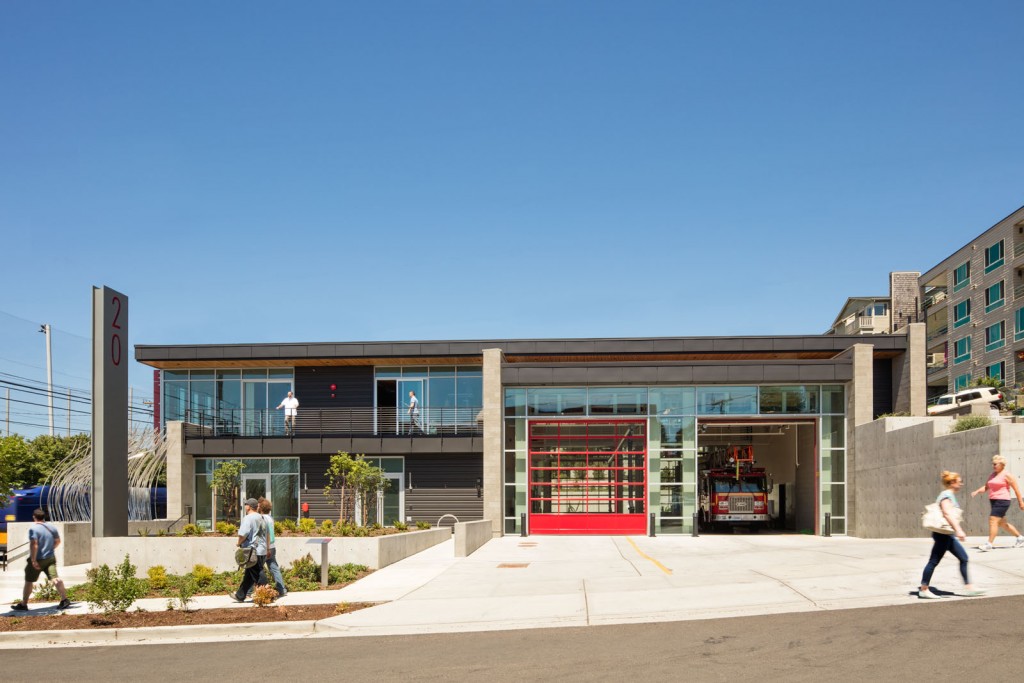
Site and building features
Prior to the new development, Fire Station 20, located in residential Queen Anne, was assessed by the City as too small, ageing and inadequate for contemporary emergency response requirements. Following investigation, 4 lots were secured at the intersection of Interbay and West Queen Anne, allowing expansion and the ability to accommodate a drive-thru design, though presenting several challenges due to a former landfill in the area and the site’s significant slope. The development improved local amenity by creating a new sidewalk connection along W Armour Street to provide safe pedestrian access between the hill climb to the residential buildings of Queen Anne and the Rapid Ride bus stops located in front of the station.
The layout of the station is divided into distinctive sides referred to as the “dirty” and “clean” house. The “dirty” house encompasses the Apparatus Bay which has capacity for 2 engines, workshop space, marine and oxygen storage areas. This side of the building has a walk in shower and a special washing machine known as an extractor, both modern features of fire stations, ensuring any contamination cannot spread. A storage space with radiant heating keeps uniforms dry when not in use, an important aspect of maintaining uniforms as they go through extreme wear and tear.
The main entrance is located on the “clean” side and leads to the lobby and station office. During duty, fire fighters can be affected by extreme temperatures and exposed to stress. The building’s climate controlled spaces are essential for supporting recovery and comfort after an emergency. The kitchen, TV room and bunk rooms have been designed to support rest and recovery, by enabling light levels to be controlled and noise minimized. The physical training room, with views over the neighborhood, helps the crew maintain fitness for service. Whilst the layout enables use of the stairs between the first and second floor, the building is designed to be accessible and integrates an elevator, for visitors to the station for public open houses and school tours.
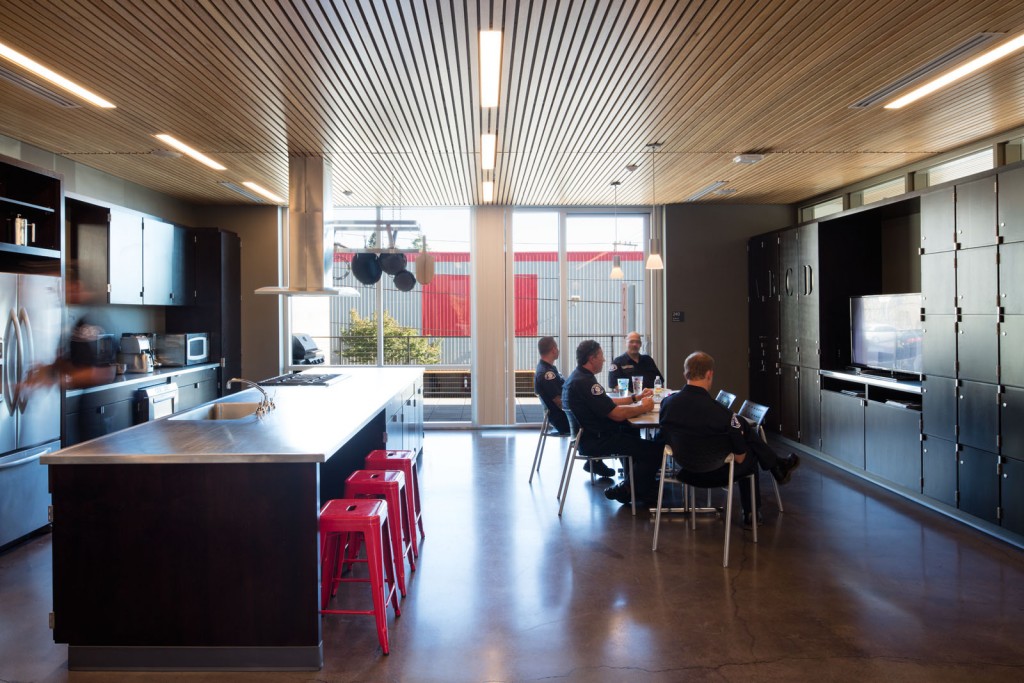
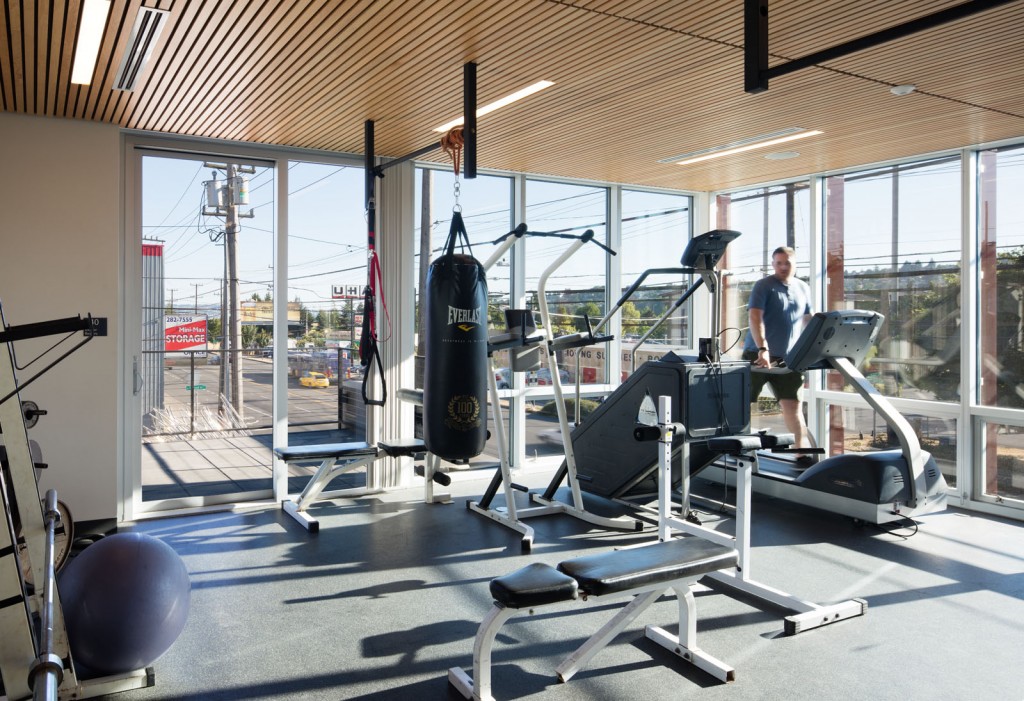
Design features
Initial energy models for Fire Station 20 indicate a 70% saving compared to a typical building. Fire stations generally require systems 24 hours a day, placing additional demands on energy and making sustainability standards challenging to meet. This significant saving is attributed to making the right moves with design up front by orientating the building to maximize natural light and selecting highly efficient mechanical systems.
During the day, minimal artificial lighting is required due to orientation and expansive windows. Efficient LED lights are incorporated throughout the building and used when required. Solar panels are discreetly integrated into the roof, generating approximately 30% of required energy. 14 geothermal wells beneath the ground take advantage of the earth’s stable temperatures. Water is circulated through pipes extending into the ground to extract or discharge heat to efficiently warm and cool the building. The constant opening and closing of the Apparatus Bay doors creates an inconsistent temperature that is inefficient to control. To combat this, the building is the first fire station in Seattle to incorporate a radiant heating system, helping to stabilize the temperature. A heat recovery system captures and reuses 75% of the exhaust heat that would otherwise be lost from the building. A generator provides backup power to the fire station in the event of an emergency. There are two charging stations for electric vehicles. Throughout, low flow plumbing fixtures are used, resulting in a 43% reduction in water use.

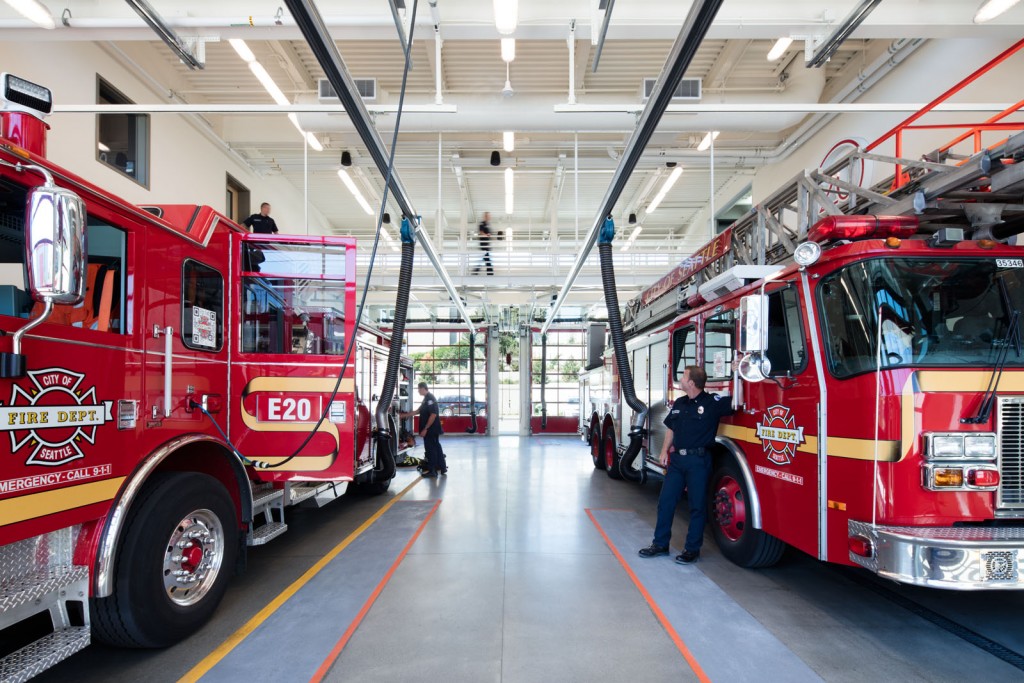
Materials were considered for their durability, environmental and health impacts. 90% of materials from the demolition of existing buildings on the site were able to be salvaged for recycling. Approximately 30% of the new building was constructed from recycled materials. Some materials were selected for their environmental credentials. Examples of this include use of materials with low levels of volatile organic compounds to improve indoor air quality and the integration of environmentally friendly zinc in the siding as it has a 60 year plus life-span and is able to be 100% recycled.
Schacht Aslani Architects collaborated with landscape architects Nakano Associates to soften the industrial character of the street. The landscaping creates a visual connection with nature that complements the steep slope of the site and civic features of the building. Two green roofs create additional space for landscaping and help to reduce and filter stormwater. Managing stormwater at the site was important given the proximity to the Lake Washington Ship Canal and potential impact on marine life. Water that falls on the roof is directed to a bio-retention planter where it is filtered by a series of plants, soil and gravel.
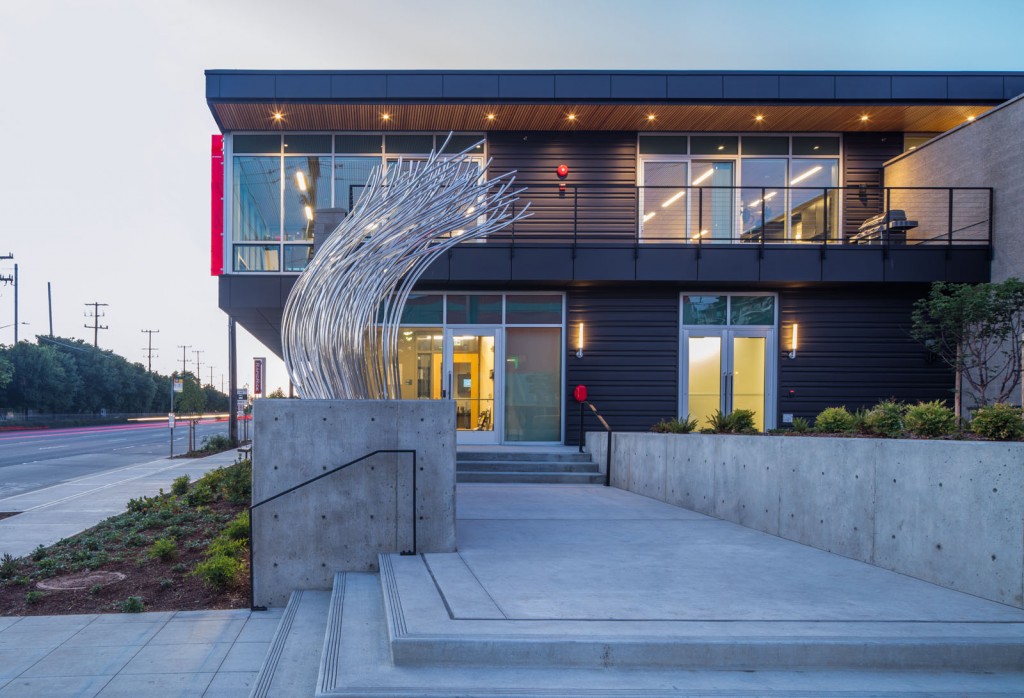
The crew were interested in integrating a vegetable garden due to the popularity of the one at the old station. The thriving vegetable garden provides a variety of produce enjoyed by the firefighters, offering additional benefits of healthy eating and social interaction through gardening and cooking.
A series of terraced garden beds soften the appearance of the retaining wall which helps to relate to the residential buildings in Queen Anne. Lattice-style fencing along the alley is intended to provide a green screen once climbing plants mature. Native and drought tolerant plants are used throughout the landscape as they need very little water once established.
Wind and Water, a striking artwork by Rob Ley marks the entrance to Fire Station 20. Ley described that the smoke-like forms of stainless steel tubing references the role of wind and water as a fire suppressor. The piece was commissioned as part of the City of Seattle public art program and creates visual interest for people passing by.
Information sharing
To engage with and inform the community about the building, a large flip-dot sign on 15th Avenue W displays real-time environmental performance information. The sign uses minimal energy and is complemented by interactive signage about energy, water and carbon savings as well as solar generation.
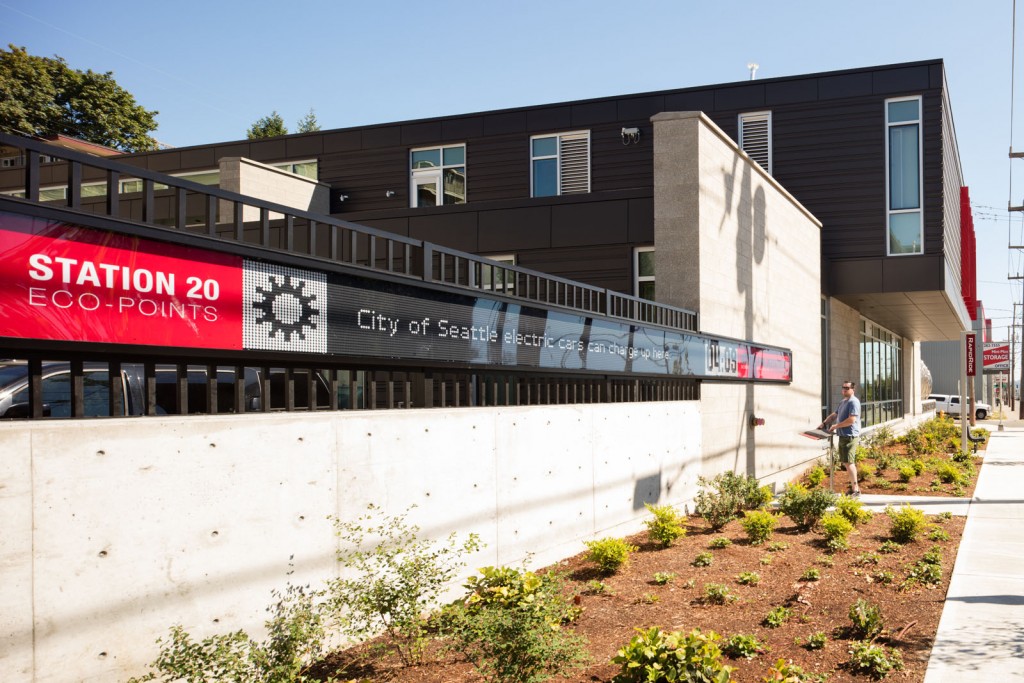
The City’s fire station initiative and sustainability goals provided opportunity for architects involved in the different buildings to share information about the efficiency, costs and challenges of different mechanical systems and learn from each other. Projects benefited from the experience of earlier developments, reflecting an economy of scale which promoted efficiency and innovation. The earlier involvement of Schacht Aslani Architects in the design of Station 30 involved conversations with crews, neighbors and a range of built environment professionals which helped to build a wealth of knowledge which influenced the design of Fire Station 20. The firm describes that the learnings from the sustainable design of Fire Station 20 have been shared with architects working on other station projects.
Fire Station 20 has an Energy Management and Control System which monitors and regulates the building to sure it is operating efficiently. This helps generate information which continues the legacy of sharing knowledge of design outcomes to benefit future city projects. The building is considered the pinnacle of the City’s fire station redevelopment and sustainability initiative and is anticipated to save money over the long term as a result of its low energy and water consumption. Fire Station 20 serves as an excellent model for sustainability, reflecting the innovative design by Schacht Aslani Architects and the City’s commitment to improving the environmental performance of its buildings.
Sarah is an urban planner and artist from Melbourne Australia, currently living in Seattle. She has contributed to diverse long-term projects addressing housing, transportation, community facilities, heritage and public spaces with extensive consultation with communities and other stakeholders. Her articles for The Urbanist focus on her passion for the design of sustainable, inviting and inclusive places, drawing on her research and experiences around the world.


